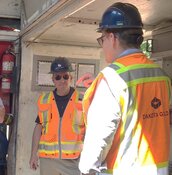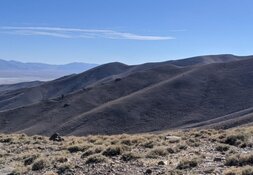The Gold Report: Kerry, Haywood Securities recently published its Q3/13 Junior Exploration Report, which tells prospective investors about 17 exploration companies across a range of mine commodities. There were 20 companies covered in the Q2/13 report. Six of those have since been removed, while three new companies were added. Why does the report have such a short-term investment horizon?
Kerry Smith: Our focus is to identify companies that will have meaningful news in the next three months that could impact the share price. We're looking for companies with projects that we like from an exploration perspective and we have a Ph.D. geologist who is charged with making sure the names in the report offer geologic potential.
TGR: Investors typically take a longer-term view of mining equities, but do you believe you can make money with a short-term horizon?
KS: If a company has meaningful catalysts coming in the next three months, money can be made by investing in it. I would agree that, ultimately, the way investors make real money in the space is by investing in an exploration play that makes a discovery and staying invested until it has been drilled off to a resource stage. Typically, investors would want to sell before the company starts talking about permitting, construction and project finance because that's when a company goes into a huge vacuum—there is no news and the stock rolls over.
"We look for companies with the potential to deliver an economic discovery with compelling margin potential and high project returns."
We're trying to find companies that can deliver decent catalysts in the short term. It's a constantly evolving list. We roll names off, and we roll names on.
TGR: There are hundreds of exploration plays. At a time when investors are eschewing risk, what do those three new companies in the report have in common?
KS: We like the projects that they are working on. There is the potential for a discovery or they already have a discovery with the potential to grow. The corollary is that the valuations are relatively modest.
Our primary criterion is the potential to deliver an economic discovery with compelling margin potential and high project returns. A company like NovaCopper Inc. (NCQ:TSX.V; NCQ:NYSE.MKT) controls a world-class, volcanogenic massive sulfide, base metals belt in Alaska. It will continue to deliver meaningful news. CEO Rick Van Nieuwenhuyse is an exploration geologist. He's very good at dealing with First Nations issues and exploring for and finding deposits. This is an exploration story, and that's what he is good at.
NovaCopper could stay on our list for some time because it's in an established district with established discoveries. That is the kind of deposit that can make it in this market.
TGR: Did any new investment themes come to light while assembling the report?
KS: The market is looking for projects with high grades, low political risk and lower capital expenses (capex). It's impossible to finance a 1 billion ton ore deposit with $2–4 billion ($2–4B) in capex. The market is looking for bite-size projects, like a heap-leach project with a $100 million ($100M) capex.
"The market is looking for projects with high grades, low political risk and lower capital expenses."
Investors are also interested in open-pit milling operations where the mill is a straightforward, cyanide-leach circuit. It's not complicated metallurgy and companies can get good recoveries.
It all comes down to margin. You can have a good-grade, open-pit deposit, but if the strip ratio is 20:1, it's not going to be very interesting economically.
In my opinion no junior company should be focused on a project that delivers less than a 30% return after tax at a gold price of about $1,200/ounce ($1,200/oz). A project that needs $1,300/oz gold to get a 15% or 20% return is destined to fail in the near term.
There are way too many projects that are being pursued and promoted that aren't high-return projects.
TGR: The commodity price charts in your report look fairly stable, perhaps with the exception of uranium. Which commodities are you most bullish on?
KS: We are the most bullish on the commodities that are most out of favor: zinc, uranium, iron ore and gold. The longer these metals stay out of favor and the less new supply comes into the market, the better the fundamentals will be going forward.
TGR: Most of the companies in the report are working on projects in North America, which is a safe jurisdiction. What are some of those companies?
KS: One of our themes is to pick stable jurisdictions. That tends to be the U.S., Canada, Mexico, Australia and Chile, to a certain extent. Some examples of companies are Balmoral Resources Ltd. (BAR:TSX.V; BAMLF:OTCQX), Probe Mines Limited (PRB:TSX.V), Newstrike Capital Inc. (NES:TSX.V), Cayden Resources Inc. (CYD:TSX.V; CDKNF:NASDAQ), Carlisle Goldfields Ltd. (CGJ:TSX; CGJCF:OTCQX) and Eagle Hill Exploration Corp. (EAG:TSX.V).
TGR: Balmoral should be putting out a resource estimate on its Martiniere project and the Bug Lake Trend this quarter. What's the early line on this?
KS: At this stage, with the limited drilling it has done, Balmoral won't get more than 1–1.5 million ounces (1–1.5 Moz) at Bug Lake. That structure is pretty complicated. It will take a lot of drilling to figure out those structures and chase these high-grade zones. But it has high grade and the potential to grow over time.
TGR: The company talked about its relationship with GTA Resources and Mining Inc. (GTA:TSX.V) in a press release. What do you know about that?
KS: Balmoral joint-ventured its Northshore project with GTA. Darin Wagner, who runs Balmoral, is a good geologist. In the current market, he probably had more projects than he could raise money to drill on. Northshore was lower priority. GTA is running the program now.
TGR: Balmoral raised $6M in a flow-through financing recently. It has about $15M now.
KS: Its 2014 burn rate is going to be in the $6–8M range. The way a flow-through works is that the company has to spend it in the next taxable year. The amount of money raised is roughly tied to planned spending next year.
TGR: What are your thoughts on the Martiniere project?
KS: Martiniere is looking OK. It's complicated geologically, though it has a number of discoveries there. It doesn't have great infrastructure either, so it's a somewhat expensive area to work in.
"There are way too many projects that are being pursued and promoted that aren't high-return projects."
In those kinds of situations, I like management teams that have a good track record, know what they're doing and know how to run these programs efficiently. Darin qualifies in that regard.
It's tricky in this market because exploration companies are constantly raising money. If a company is going to keep coming back to the market, it needs to show that it is spending those funds wisely. Darin is pretty good at that.
TGR: Probe Mines has said that it is going to put out a resource update on its Borden gold project this quarter. It's at about 4.3 Moz now. Is that going to grow?
KS: Probe's focus is on expanding the high-grade core of that deposit, which it is drilling now. The preliminary economic assessment (PEA) probably won't be available until H1/14. It's going to be a PEA on an underground operation, not an open pit.
The original plan was to develop a large, low-grade, open-pit milling deposit in Ontario. Those kinds of projects were of interest to the market two years ago when gold was pushing up to $1,923/oz. In this market, those projects have no investor appeal at all because people recognize that the grade is low and the capex and operating costs are going to be very high.
The advantage that CEO David Palmer has with the Borden project is its high-grade core, which is pretty continuous and well defined. It's going to be an underground operation, which would be significantly smaller than an open pit, so the capex will be lower. The grade Probe is targeting will be in the 5–6 grams per tonne (5–6 g/t) range. If it can come up to 1.5–2 Moz, 5–6 g/t material that it can mine underground, it would be a lot more interesting.
That's part of the reason that Agnico-Eagle Mines Ltd. (AEM:TSX; AEM:NYSE) has come into the story. Agnico is now a strategic shareholder of this company. Agnico's primary interest is in the belt because this is a new discovery in a part of Ontario that historically hadn't been well explored for gold. Agnico knows how to mine 5–6 g/t gold deposits in Ontario underground because it has mined them for the last 40 years. If Probe can't develop a large, open-pit milling operation at 1–1.25 g/t, there is an opportunity here for Agnico. There's optionality that it could also mine a higher-grade underground deposit. That kind of expertise is pretty well established within Agnico-Eagle.
TGR: Probe is conducting an 80,000 meter drill program as we speak, which is probably about two-thirds completed. What is it hoping to achieve?
KS: It's trying to better define a high-grade core and convert Inferred to Measured and Indicated. The high-grade core starts at a couple of hundred meters below surface in the guts of it, so it would be more amenable to underground. That's one reason why Probe is looking at this option.
TGR: What sort of cash does Probe have?
KS: It has about $36M today, so it is well funded. Its 12-month budget for 2014 is in the range of $12–15M. It still has at least two years of cash. There are not too many junior companies that can say that.
TGR: Are there some other companies that you want to talk about in North America?
KS: There are some other stories elsewhere, like Reservoir Minerals Inc. (RMC:TSX.V) in Serbia. It is a 25% partner with Freeport-McMoRan Copper & Gold Inc. (FCX:NYSE) on a copper discovery that is extremely high grade. We're primarily interested in margin, and that generally comes from better grades.
TGR: I don't think any list would be complete without some companies working in Mexico. Do you want to head there?
KS: Cayden Resources has done pretty well in this market. It is drilling its El Barqueño project with excellent trench results. Everybody is waiting for the drill results from its 25-hole program. I'm hoping that we'll see continuity to depth from those structures that it was able to trench on surface. We should get assays in the next month or so.
TGR: Are you familiar with the Guerrero Gold Belt and the geological prospectivity there?
KS: We are. We have three Ph.D. geologists on staff. Torex Gold Resources Inc. (TXG:TSX) came out with a resource on a project on the belt. It wasn't even its main project and it was around 5 Moz. That's not very far from where one of Cayden's other projects is.
The Guerrero Gold Belt is pretty exciting. Goldcorp Inc. (G:TSX; GG:NYSE) is there. Newstrike Capital is there. Osisko Mining Corp. (OSK:TSX) staked hundreds of thousands of hectares there.
TGR: Do you expect a lot of significant news from mining companies in Q4/13?
KS: There are about 3,000 exploration companies. Probably three-quarters aren't spending any money at all. There are companies that have some money, but they're doing nothing. In some cases, it's actually the right strategy because the risk an explorer runs in a market like this is that it depletes its treasury and the news it gets has no meaningful impact on valuation. If that's the case, a company is better off just sitting on the project.
Probably 85% of those 3,000 companies don't have projects that make much sense in this market, either because the grade is a bit skinny or the capex is so prohibitively large that even if they did manage to drill it off and get a feasibility done, they'd have no way to finance it. And those projects aren't the kind the majors want to buy.
The gold is not going bad in the ground. Just sit on the project. Wait until the market is more receptive and live to fight another day.
TGR: The report notes that financings dropped to less than 600 year-to-date versus more than 1,275 financings during the same period of 2012. The total cash raise dropped to about $2.25B in 2013 from $8.83B in 2012. Is that trend showing any sign of a slowdown or reversal?
KS: It's not getting any better. The only money out there for a junior exploration company is flow-through, which means it has to be in Canada.
There's also hope for companies like Roxgold Inc. (ROG:TSX.V) in Burkina Faso, which is drilling on a project, has a resource and is working toward developing its project. But the average grade of the deposit is high at about 15 g/t and it would be underground. Those kinds of projects can finance themselves.
The other thing in this market that has changed is mergers and acquisitions (M&A). There has been selective M&A in this market, but it tends to be situations like Alamos Gold Inc. (AGI:TSX) buying Esperanza Resources Corp. or Orsa Ventures Corp. Alamos paid $4M for Orsa Ventures, and it picked up a 3 Moz deposit in Oregon. Companies can pick up resources cheaply. They can inventory them into their pipeline.
In the case of Esperanza in Mexico, it's a development-stage project that needs permits. The project gives Alamos the opportunity to push ahead on the permitting side while it is continuing to generate cash from its existing base of operations. Those are the kinds of projects that could get acquired, but the majors generally are not buying anything. Their shareholders have been pretty clear that they don't want anything like what IAMGOLD Corp. (IMG:TSX; IAG:NYSE) did, paying $600M for Trelawney Mining and Exploration Inc. That project is not economic at these gold prices, for sure.
If larger companies can deliver growing, free cash flow and can raise their dividends, share prices will move up. Eventually, the valuations on the majors will reach a level where they would be prepared to buy something.
Companies just have to hunker down and conserve their cash as best they can. It's not an easy market.
TGR: Thanks for your insights.
Kerry Smith, research analyst at Haywood Securities, has been a mining analyst since 1992. He was a mining engineer with 10 years of mine experience and holds a Master of Business Administration degree.
Want to read more Gold Report interviews like this? Sign up for our free e-newsletter, and you'll learn when new articles have been published. To see a list of recent interviews with industry analysts and commentators, visit our Streetwise Interviews page.
DISCLOSURE:
1) Brian Sylvester conducted this interview for The Gold Report and provides services to The Gold Report as a contractor. He or his family own shares of the following companies mentioned in this interview: None.
2) The following companies mentioned in the interview are sponsors of The Gold Report: Balmoral Resources Ltd., Probe Mines Limited, Cayden Resources Inc. and Roxgold Inc. Goldcorp Inc. is not affiliated with The Gold Report. Streetwise Reports does not accept stock in exchange for its services or as sponsorship payment.
3) Kerry Smith: I or my family own shares of the following companies mentioned in this interview: None. I personally am or my family is paid by the following companies mentioned in this interview: None. My company has a financial relationship with the following companies mentioned in this interview: None. I was not paid by Streetwise Reports for participating in this interview. Comments and opinions expressed are my own comments and opinions. I had the opportunity to review the interview for accuracy as of the date of the interview and am responsible for the content of the interview.
4) Interviews are edited for clarity. Streetwise Reports does not make editorial comments or change experts' statements without their consent.
5) The interview does not constitute investment advice. Each reader is encouraged to consult with his or her individual financial professional and any action a reader takes as a result of information presented here is his or her own responsibility. By opening this page, each reader accepts and agrees to Streetwise Reports' terms of use and full legal disclaimer.
6) From time to time, Streetwise Reports LLC and its directors, officers, employees or members of their families, as well as persons interviewed for articles and interviews on the site, may have a long or short position in securities mentioned and may make purchases and/or sales of those securities in the open market or otherwise.


 There are no easy answers in this market. Companies and investors alike have to hunker down and make tough calls, but that doesn't mean companies and investors can't make money, even in the short term, says Kerry Smith, a research analyst with Haywood Securities. Smith and Haywood's staff geologists narrow their sights on small companies cheaply exploring for beaten-up commodities. In this interview with
There are no easy answers in this market. Companies and investors alike have to hunker down and make tough calls, but that doesn't mean companies and investors can't make money, even in the short term, says Kerry Smith, a research analyst with Haywood Securities. Smith and Haywood's staff geologists narrow their sights on small companies cheaply exploring for beaten-up commodities. In this interview with 






































